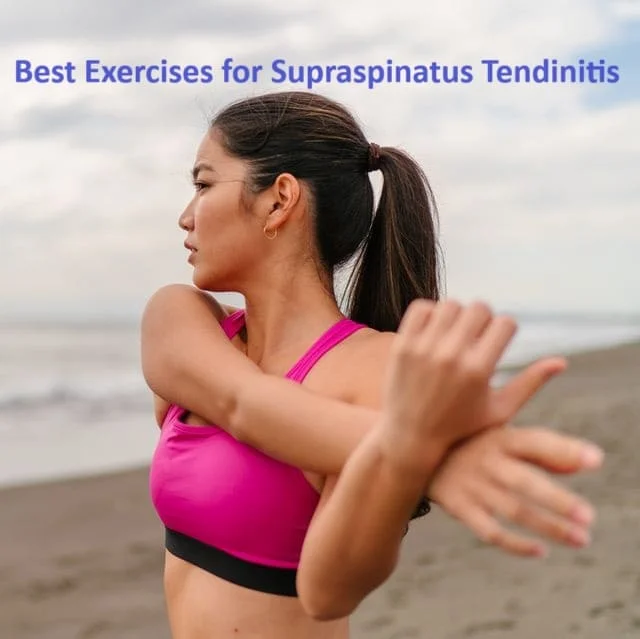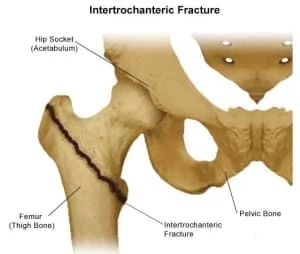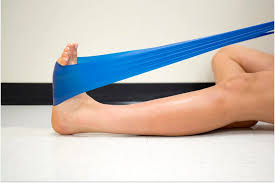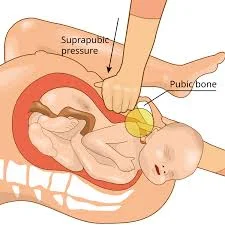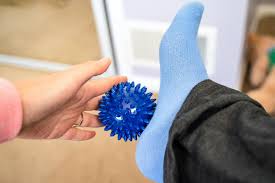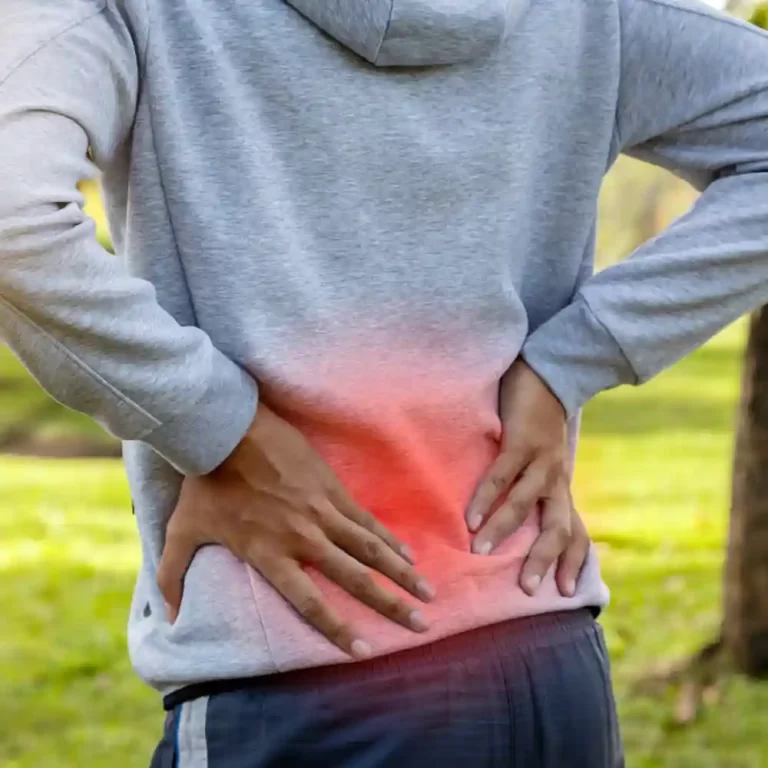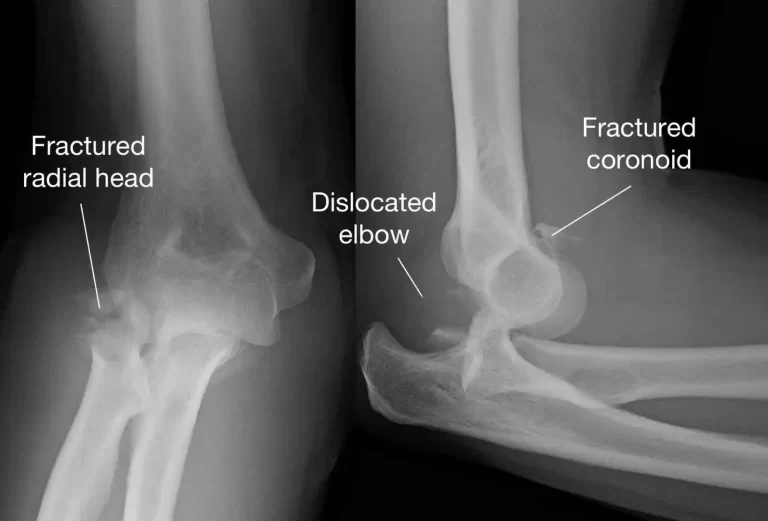24 Best Exercises for Supraspinatus Tendonitis
Exercises for Supraspinatus Tendonitis is an important part of your overall treatment plan along with Physical therapy, Pain medication, and Rest.
The supraspinatus is a component of the muscles of the rotator cuff. The painful condition known as supraspinatus tendinopathy, which becomes more common around middle age, happens to be one of the most common causes of shoulder pain.
Supraspinatus tendinitis is a muscular condition that can cause inflammation and pain in the shoulders. It could hurt your quality of life and your regular activities.
The program should be followed under your doctor’s guidance to ensure your health and effectiveness. To find out which exercises will help you reach your rehabilitation goals, consult your physician or physical therapist.
What is supraspinatus tendinitis?
The supraspinatus tendon, a thick layer of fibrous tissue that joins the supraspinatus muscle to the shoulder joint and is a component of the rotator cuff, is connected to the supraspinatus muscle, which is placed in the supraspinatus fossa behind the scapula.
The purpose of the supraspinatus tendon is to help with movement of the arm upward. Damage or injury to the supraspinatus tendon is known as supraspinatus tendinopathy.
Due to degradation caused by aging normally, It often develops in the 50s and causes all of the rotator cuff tendons to degenerate as the muscles under them weaken. Tennis and badminton players, whose sports require throwing and overhead motions often and repeatedly raise their arms above shoulder level, are among the sportsmen for whom it is a common cause of shoulder pain.
Supraspinatus tendinopathy is mostly caused by tendon impingement, which may result from subacromial loading. Muscle imbalance and rotator cuff overuse are additional factors.
Introduction:
Exercise plays an important part in your entire treatment plan for supraspinatus tendonitis. To make your supraspinatus muscle stronger, try some exercises. Effective muscular function can be improved by regular exercise. Long-term pain reduction is possible with exercise. Exercise gives your shoulder joint more strength and stability.
Keeping your shoulder joint stable can be achieved by strengthening the muscles that support it. By maintaining these muscles’ strength, shoulder pain can be reduced and other injuries can be avoided. Stretching the muscles you have strengthened is necessary for recovering your range of motion and preventing injury. After performing strengthening activities, gently stretching your muscles could help prevent pain and maintain their length and mobility.
A program of exercise conditioning can help you in getting back to your regular activities and living a healthier, more active lifestyle. Following a carefully organized conditioning program could assist with your return to sports and other hobbies that you enjoy.
Symptoms:
- Pain
Pain referred down the lateral portion of your upper arm can go along with this, which may be limited to the lateral or anterior region of your shoulder.
- Painful range of motion
You may have painful abduction, internal rotation, or external rotation. In addition, you may experience severe arch pain that spreads across your shoulders.
- Muscle weakness
This is felt more when the arm is abducted or the shoulder is rotated externally.
- Functional Impairments
These can include trouble pushing, lifting, moving overhead, and rotating your shoulder internally, such as when you move your hands behind your back.
Among the typical signs of supraspinatus tendinopathy are;
- Feel pain when stretching your hand
- Tenderness
- Slight edema
- Continuous tightness in the area of the shoulder
- Producing a clicking noise and lifting your arm
- Inability to sleep at night on one’s side with the injured shoulder
The Following Are Typical Causes of Supraspinatus Tendonitis Tears:
- Age:
As we age, the supraspinatus tendon experiences degeneration that might result in supraspinatus tendonitis.
- Supraspinatus and Rotator Cuff Repetitive Movement:
Sports-related movements such as weightlifting, tennis, swimming, baseball, and other activities that call for repeatedly performing the same motions might be considered repetitive movements.
- Spurs in the Shoulder Bone:
Bony structures called bone spurs, which can form along the margins of the bone may result in friction that causes pain, inflammation, and tear in the tendons that attach to the rotator cuff.
- High-intensity activity:
Hefty lifting that is done repeatedly and overhead.
- Low Circulation:
Insufficient blood supply can also result in a shoulder injury since it affects the body’s capacity to mend damaged or torn soft tissue and reduce inflammation.
Benefits of Exercises for Supraspinatus Tendonitis
The following are the advantages;
- Reduce shoulder pain.
- Increase the shoulder joint’s range of motion.
- You can reduce joint pain and stiffness by exercising.
- Shoulder joint tightness can be relieved with exercise.
- Improve your coordination and balance.
- Improve Your Flexibility.
- Increasing strength is a great benefit of exercise.
When beginning an exercise treatment, take into consideration the following safety measures:
A few safety measures and maximizing the benefits should be considered before beginning any exercise program. To find the right workouts for your particular problem, speak with your doctor or physical therapist.
It’s important to pay attention to what your body requires and avoid using force when experiencing pain. While some pain is a common side effect of exercise, continuous or severe pain may be a sign of overwork. When you can tolerate more pain, start with low-impact exercises and work your way up to more challenging ones.
It’s important to keep up good technique and posture to prevent repeated injuries. Get medical advice if you’re unsure about how to put out your exercise routine correctly. To properly prepare your joints and muscles for the activity, warm up before beginning any exercise.
Best Exercises for Supraspinatus Tendonitis
The best exercises to help you improve your shoulder movement are listed below.
Shoulder Pendulum
- Begin with a Place yourself beside a table.
- Bend a little bit forward.
- Place your unaffected shoulder’s hand down on the table.
- With your good arm resting on a table, you can bend over.
- Using your hand, carefully begin to swing the relaxed arm now.
- After moving your arm back and forth or your hand in a circle, switch directions.
- After that, gradually return to your neutral position.
- Next, relax.
- Five to ten repetitions of the exercise are suggested.
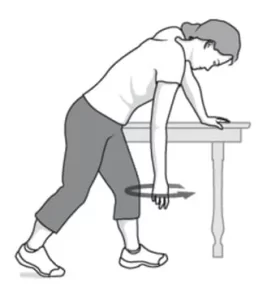
Side-Lying External Rotation
- Place your palm against your abdomen and bend your right elbow to a ninety-degree angle as you begin in a relaxed left sideline position.
- Use your right hand to hold a one- or two-pound weight.
- Afterward, gradually raise the hand weight in front of you until your forearm is straight.
- Hold this position for a few seconds.
- After that, slowly rotate your arm so that it is towards your abdomen to return to your neutral position.
- Next, relax.
- Five to ten repetitions of the exercise are recommended.
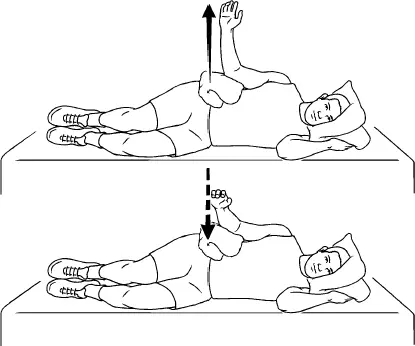
Prone Full Can Raise
- Start on the floor in a prone position that looks comfortable.
- Now straighten your arms out to an elevation that matches your shoulders.
- After that, raise your arms off the ground and turn your thumbs to face up.
- Hold this position for a few seconds.
- After that, slowly move your hand down to your neutral position.
- Next, relax.
- Five to ten repetitions of the exercise should be done.
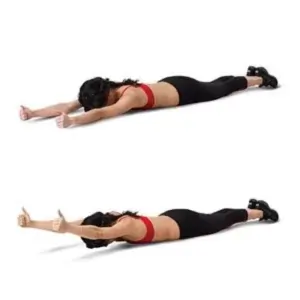
Scapular protraction and retraction
- Begin in a comfortable standing position.
- Relax your neck and head.
- Squeeze your shoulders back gently.
- Hold this position for a few seconds.
- Do not shrug your shoulders.
- Then slowly return to your neutral position.
- Then relax.
- It is recommended to perform exercises five to ten times.
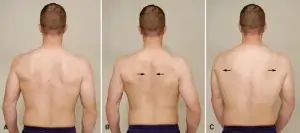
Across-the-chest stretch
- Choose a comfortable location on the ground to start.
- Take your right arm and hold it to your chest.
- Hold it with your left hand or place your arm in the gap made by your left elbow.
- Keep this position for a few seconds.
- Then return to your neutral position.
- Then relax.
- Five to ten repetitions of the exercise should be completed.
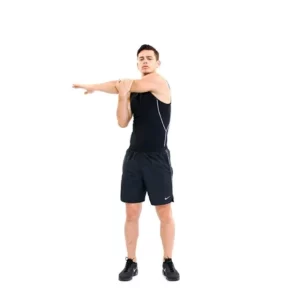
Sleeper stretch
- Lying on your side on a level surface, place your affected arm on the table and bend your elbow to a 90-degree angle.
- After that, apply gentle pressure on your forearm with the opposing arm.
- Hold this position for a few seconds.
- Then return to your neutral position.
- Then relax.
- It is recommended to perform exercises five to ten times.
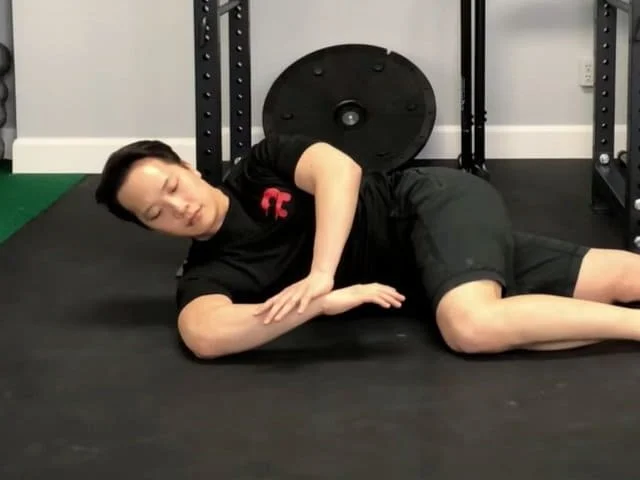
Front Support on Medicine Ball
- Pick up a medicine ball and hold it under your palms.
- Now raise yourself into a push-up position, placing your hands on the ball and your toes on the ground.
- Hold this position for a few seconds.
- Then return to your neutral position.
- Then relax.
- It is suggested to complete workouts five to ten times.
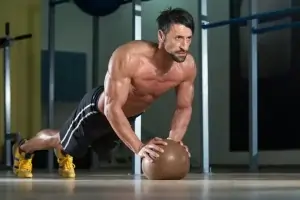
Sword exercise
- Install a cable as low as you can, especially with a flexible handle.
- Holding the handle with the hand that is closest to the machine, stand with your legs shoulder-width apart.
- Place your hand first close to your opposing hip.
- Breathe in as you extend your arm across your body as if removing a sword from its socket.
- Your arm should be completely extended and at about 45° angle when you finish.
- As you carefully return to the beginning posture, release the breath.
- Maintain a downward shoulder during the entire movement.
- Then return to your neutral position.
- Then relax.
- Repeat this exercise 5-10 times.
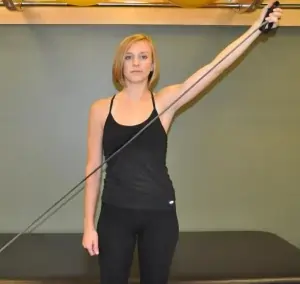
High-to-low rows
- A resistance band should be attached to something significant that is at least shoulder height.
- Make sure it is tight enough that pulling on it won’t cause it to come loose.
- Begin a kneeling position with the knee lifted against the affected arm.
- Your lowered knee and your body should line up.
- Place the other hand down on your lifted knee.
- Pull your elbow inside toward your body while maintaining a tight grip on the band with your arm extended.
- As you pull, maintain a straight back and squeeze your shoulder blades downward and together.
- Your arm shouldn’t shift or twist about your body.
- Then return to your neutral position.
- Then relax.
- Repeat this exercise 5-10 times.
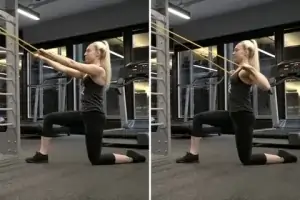
Prone rows
- Place yourself on a table or bench with a dumbbell in each hand and lie chest down.
- Lift the weights by using your elbows to direct them up while maintaining your chest pushed on the bench.
- Hold this position for a few seconds.
- Then return to your neutral position.
- Then relax.
- Workouts should be finished five to ten times.
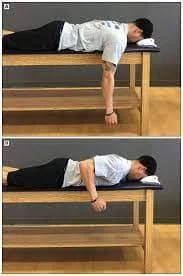
Prone extension
- Start with lying face down on the bed or table.
- Raise your arms slowly upward while maintaining a straight elbow position.
- Hold this position for a few seconds.
- Then lower your arm.
- Then return to your neutral position.
- Then relax.
- Workouts should be finished five to ten times.

Side lying abduction
- Start with a relaxing side-lying position on the bed.
- Maintain a straight elbow position with your thumb pointing up at the ceiling.
- As soon as your arm is straight and supported by your hip, slowly raise it toward the ceiling.
- Make sure your thumb is still pointing up at the ceiling and that your arm is parallel to your body.
- Go through the entire range of motion in your shoulder pain-free.
- Hold this position for a few seconds.
- After that lower your arm.
- Then return to your neutral position.
- Then relax.
- Workouts should be finished five to ten times.
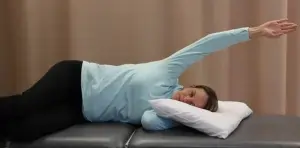
Arm reach
- Engage the abdominal muscles while lying flat on your back and extend your arms and legs.
- Raise one arm to the ceiling so that the shoulder blade is raised above the ground.
- Hold this position for a few seconds.
- Put your arm back on the floor.
- Then return to your neutral position.
- Then relax.
- Workouts should be finished five to ten times.
Face pulls
- A cable pulley machine should be set up with the pulley system slightly above your head.
- For this exercise, use the rope attachment with the two hand-holds.
- With your palms pointing inside, raise your arms and hold the handles with both hands.
- Take a step back until your arms are completely extended, then slightly lean back, bringing your body to a roughly 20-degree angle.
- To maintain proper posture and prevent your shoulders from bending or rolling forward, pull the rope toward you only far enough to begin raising the weight of the top of your shoulders.
- Straight toward your forehead, pull the attachment’s handles.
- To activate the back delts, keep your hands facing forward while extending your elbows out to the sides.
- Reverse the movement and slowly extend your arms, taking care to keep your chest and shoulders from rolling forward.
- During the workout, you should keep your posture straight.
- Then return to your neutral position.
- Then relax.
- Workouts should be finished five to ten times.
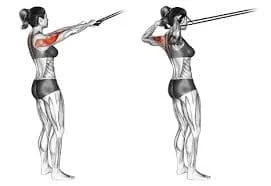
Reverse Lateral Dumbbell Raises
- During this exercise, keep your elbows slightly bent.
- Place your feet hip-distance apart and slightly bend your knees.
- With both hands, grasp a dumbbell and place your arms next to your body.
- Bend forward at the hips while extending your spine and contracting your core.
- Check that your entire body is almost parallel to the ground.
- With your palms facing each other, let your arms swing below your shoulders.
- As you raise the weights to the sides, contract your shoulder blades.
- When your elbows reach your shoulder level, stop.
- Then return to your neutral position.
- Then relax.
- Workouts should be finished five to ten times.
Standing band row
- Begin in a comfortable standing position.
- Face the object you want to attach the elastic band to, such as a door.
- Using your hand, hold the band while standing.
- Now, bring your elbow to a 90-degree angle while keeping it close to your body.
- Hold this position for a few seconds.
- Return the elbow to its starting position.
- Then return to your neutral position.
- Then relax.
- Repeat exercise 5-10 times.
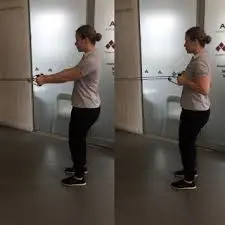
Internal shoulder rotation
- First, choose a comfortable place on the ground where you can stand.
- You can attach a large resistance or elastic band to a doorknob.
- Using one hand, grab the opposite end of the band.
- Bend the arm at the elbow and bring the forearm near to the body.
- Maintain this position for a few seconds.
- Then return to your neutral position.
- Then relax.
- Repeat exercise 5-10 times.
Abduction Horizontal
- As you lie on your stomach, your affected arm should be hanging over the side of the table or bed.
- Keeping your arm straight, slowly raise it to eye level.
- Hold this position for a few seconds.
- Slowly lower your arms.
- Then return to your neutral position.
- Then relax.
- Repeat exercise 5-10 times.
Internal and external rotation
- Start with a relaxing lie-down position on the ground.
- Extend your arm straight out from your shoulder and extend your elbow 90 degrees to point your fingers outward.
- Keeping your elbow bent and your body in the right position, slowly move your arm at the correct angle.
- If you have pain at a 90° angle, flex your elbow to a 45° angle.
- Then return to your neutral position.
- Then relax.
- Repeat exercise 5-10 times.
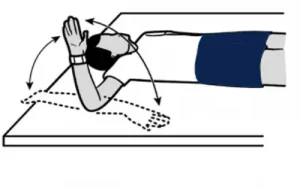
Shoulder isometric external rotation
- Approximately a few inches away from a wall, standing parallel to it.
- The shoulder you are working on should be the one nearest to the wall.
- Make a punch with your hands, bend your elbow 90 degrees, and press the back of your hand into the wall as though you were turning your arm outwards.
- If you need a little support, use a tiny towel.
- Press into the wall gently for around a few seconds.
- Hold this position for a few seconds.
- Release the pressure on the wall gradually.
- Then return to your neutral position.
- Then relax.
- Repeat exercise 5-10 times.
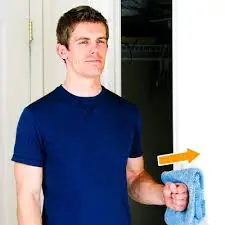
Shoulder isometric internal rotation
- Face a door frame or the outside corner of a wall with your body in this position.
- The door entrance or corner is where you should be exercising your shoulder.
- Making a punch and bending your elbow 90 degrees, gently press onto the door frame or corner wall as though you were attempting to twist your hand inside towards your belly button.
- Press and hold for a few seconds.
- Then return to your neutral position.
- Then relax.
- Repeat exercise 5-10 times.
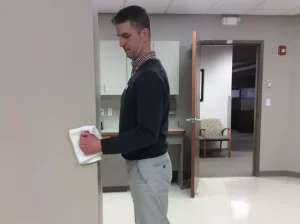
Scapula Setting
- Place your arms at your sides and lie on your stomach.
- Should you need to, put a pillow under your forehead for comfort.
- As far down your back as you can, gently pull your shoulder blades together.
- Hold this position for a few seconds after relaxing off generally halfway.
- Then return to your neutral position.
- Then relax.
- Repeat exercise 5-10 times.
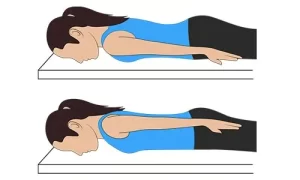
External rotation with arm abducted 90°
- Using the elastic band, create a loop that is three feet long, then connect the ends together.
- Connect the loop to a stable item, such as a doorknob.
- Holding the band, raise it to shoulder height and bend your elbow 90 degrees.
- Raise your hand slowly until it is in line with your head while maintaining the level of your elbow and shoulder.
- Then return to your neutral position.
- Then relax.
- Repeat exercise 5-10 times.
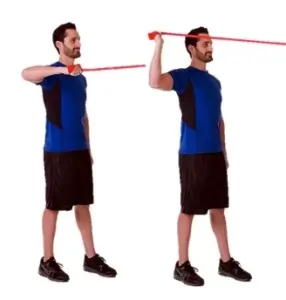
External shoulder rotation
- You can attach a large resistance or elastic band to a doorknob.
- With your elbow bent and by your side, grasping the band as you stand.
- Turn your arm outward slowly, keeping your elbow close to your side.
- Pulling your elbow back will cause you to squeeze your shoulder blades together.
- Hold this position for a few seconds.
- Then return to your neutral position.
- Then relax.
- Repeat exercise 5-10 times.
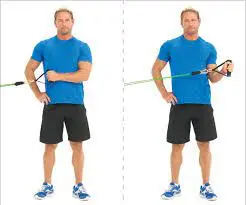
Advice to remember when working out:
- It is important to do all exercises following the protocol, which calls for stretching before and after each exercise as well as the right amount of repetitions for each.
- When working out, wear comfortable clothing for your body to move in. Avoid dressing too tightly.
- Stretch and get yourself warmed up before starting any exercise.
- A tight muscle can be safely stretched, and even if it hurts, it shouldn’t hurt too much or too suddenly.
- Exercise should be immediately stopped if you experience any form of pain.
- Take breaks between the exercises you do.
- Before working out, eat something light.
- Avoid doing a lot of intense physical activity.
- Make sure there is enough space around you and remember to stay hydrated with water when you’re working out to avoid getting hurt.
When did you stop working out?
- Fever
- Headache
- When resting has been recommended by your doctor.
Exercises To Avoid For Supraspinatus Tendonitis:
Generally speaking, people should rest their shoulders to allow the muscles to heal. Among the exercises that individuals have to avoid are:
- Performing Weightlifting Overhead
Pressing or overhead movements should be avoided in the beginning for those who have shoulder conditions. stop exercises like ball tossing and gym-specific weight training exercises like pulldowns and overhead presses. These movements have the potential to increase the afflicted area’s stress levels, pain, and damage.
- Pulldown From Behind The Neck
One exercise to avoid tendinitis in the shoulder is the behind-the-neck pulldown, using a barbell or bar hooked to a cable. This movement overstretches the rotator cuff, increasing the possibility of additional shoulder issues and continuous pain.
The issue with the pulldown from behind the neck is “external rotation.” You must externally rotate your shoulders as far as possible to perform the behind-the-neck pulldown, It makes a very risky posture across your shoulders. By overstretching the tissues and creating instability in your joints, this exercise might injure you.
- Behind The Neck Presses
To do the behind-the-neck press exercise, your shoulders need to be maximally rotated outward. This can seriously strain your rotator cuffs and put your shoulders at risk for injury to your shoulder girdle, which is the group of bones that connects your arms to your skeleton.
When to consult a doctor for advice:
A supraspinatus tendinitis injury is a possibility for anyone who experiences any of the following shoulder symptoms, therefore they should schedule a visit with a doctor;
- Swelling
- Pain or redness surrounding the joint
- Particularly pain that is not relieved by resting
It’s important to get medical care right away if any of the following signs appear;
- Visible joint abnormality
- Intense, sudden pain
- Unexpected swelling
- Not being able to use the shoulder joint
Summary
Shoulder pain is frequently caused by supraspinatus tendinopathy. Over the Spinatus The impingement of the supraspinatus tendon as it passes below the acromion, as a result of wear and tear from repeated overhead activity and falls on the shoulder, is the usual cause of tendinitis.
Tendinitis in the supraspinatus is common. It is linked to uncomfortable arm lifts, trouble reaching upwards, and trouble sleeping at night because of pain.
Physical therapists ought to treat the decrease in strength, function, and range of motion along with handling the pain. These are the typical complaints that come with this injury. An important part of treating supraspinatus tendinitis is exercise. Maintaining shoulder range of motion and strengthening the damaged or degenerative supraspinatus tendon are the major goals of exercise for Supraspinatus tendinitis.
To be sure you are doing these exercises correctly and getting the benefits, you should practice under the guidance of a physical therapist.
FAQ:
Which exercise works the supraspinatus tendon the best?
Pendulum
Side-Lying External Rotation
Scapular protraction and retraction
Front Support on Medicine Ball
Prone extension
Side lying abduction
How is supraspinatus tendonitis treated?
Rest
Ice
Anti-Inflammatory Medication
Physical therapies
Injection of Corticosteroids
Surgery for the Rotator Cuff
Which exercises should you avoid doing if you have supraspinatus tendinitis?
Pressing or overhead movements should be avoided in the beginning for those who have shoulder medical conditions. Leave away exercises like ball tossing and gym-specific weight training exercises like pulldowns and overhead presses.
How much time does supraspinatus tendinosis take to recover?
If treatment is not working for mild cases and symptoms have been present for more than three to four months, it may take 4-6 months for supraspinatus tendinopathy to heal following surgery.
What happened if supraspinatus was weak?
Atrophy can result in loss of shoulder function, including decreased strength and the inability of the cuff to heal following surgery. The level of the atrophy is different on many factors, including age, disuse, and the amount of the tear.
Can the supraspinatus tendon heal on its own?
Although rotator cuff injuries cannot heal on their own without surgery, many patients can see a reduction in pain and an improvement in function with nonsurgical treatment by strengthening their shoulder muscles.
What is poor supraspinatus posture?
The supraspinatus tendon has less space in this place when you hunch over, bend over, or shift your shoulders. Bad posture can cause a pinched tendon to press against the subacromial bursa, which is the natural support of the shoulder.
Which effects could supraspinatus tendonitis cause?
Generally speaking, supraspinatus tendinopathy is linked to anterior instability that results in posterior tightness. The patient may experience reduced strength, functional activity, range of motion, pain, and inflammation.
In the case of a supraspinatus tear, what should you not do?
Avoid prolonged use of your arms above shoulder level when working. Use a ladder or footstool if necessary. Lift and hold items in close contact with your body. Avoid lifting large objects over your head or away from your body.
Is surgery necessary for supraspinatus tendonitis?
Surgery may be required to heal the tears and help the muscles and tendons if your rotator cuff tendonitis has damaged the tendons to the point where they have ruptured either entirely or partially.
Can surgery be used to heal a supraspinatus tear?
Even though most tears cannot heal on their own, surgery is frequently not necessary to guarantee great function. However, since many tears cannot heal without surgery, surgery is typically advised if you are active or use your arm for sports or overhead work.
How may a torn supraspinatus be healed naturally?
Sometimes, conservative measures like rest, ice, and physical therapy are all that are required to heal from a rotator cuff injury.
If it hurts, should I still work out my shoulder?
Warm up your tendons and muscles with a heating pad or a warm shower before working out. Muscle-toning activities may cause some slight pain, which should be relieved by applying ice to the shoulder. However, if you have intense or severe pain, stop the exercises for a few days.
Is tendinitis permanent?
Patients with severe symptoms might need to see a physician with arthritis, an orthopedic surgeon, or a physical therapist for expert care. Most tendinitis issues don’t cause permanent joint damage or disability if they are managed carefully.
The supraspinatus muscle is rested in what way?
Rest: After an injury, it’s important to give the muscle time to recover.
Avoid: Stay away from activities that put strain or pain on your muscles.
Ice: Using ice on the injured area can help reduce inflammation and swelling.
How can tendinitis of the supraspinatus be prevented?
Include the Upper Body in Your Exercise Program.
Avoid accidents and falls.
Keep Your Posture Correct.
Maintain a healthy weight.
Stay away from lifting, catching heavy objects, and repeatedly raising your arms.
Which are the Supraspinatus tendinopathy stages 1?
Patients under 25 are primarily affected, and symptoms include edema, rotator cuff bleeding, and severe inflammation. With certain non-operative therapy, this stage is easily reversible.
What are the stages 2 of supraspinatus tendinopathy?
Patients between the ages of 25 and 40 are affected, primarily as a result of the stage 1 scale. This is where the rotator cuff tendon progresses to tendonitis and fibrosis, which typically do not improve with conservative measures and necessitate surgery.
What are the stages 3 of supraspinatus tendinopathy?
Patients older than forty years old are primarily affected. As this problem worsens, it may cause changes in the coracoacromial arch, osteoporosis in the anterior acromion, and mechanical disruptions of the rotator cuff tendon. The rotator cuff and the surgical anterior acromioplasty arch need to be repaired here.
What is the purpose of the supraspinatus?
Pulling the humerus head medially toward the glenoid cavity and performing arm abduction are two actions that are performed by the supraspinatus muscle. It also acts on its own to keep the humeral head from sliding lower.
What is pain in the supraspinatus?
The middle part of the deltoid at the shoulder side is where supraspinatus pain is observed. The front of the shoulder may also be affected in some situations.
On which shoulder is it better to sleep?
You can sleep on the unaffected shoulder if you prefer to rest on your side and there’s only one painful shoulder. To minimize tension and pressure, it might be advantageous to sleep on your back and maintain a straight neck and back.
Why are injuries to the supraspinatus most common?
A rotator cuff tear may also result from trauma or another repetitive usage injury. Of the four tendons, the supraspinatus tendon experiences injuries the most frequently because it is primarily located between the acromion and the humeral head.
What is the supraspinatus muscle’s importance?
Supraspinatus, a component of the Rotator Cuff, helps in overcoming the forces of gravity by pulling the upper limb’s weight downward at the shoulder joint. Maintaining the humerus’ head firmly placed medially on the scapula’s glenoid fossa helps in stabilizing the shoulder joint as well.
How much time does it take to make the rotator cuff stronger?
Following six to twelve weeks of therapy, the majority of patients with rotator cuff tendinitis experience reduced pain and improved function. After many weeks of physical therapy exercises, the majority of professionals will suggest more investigation if the patient’s shoulder pain does not improve.
References:
- Tendinopathy Supraspinatus. (n.d.). https://www.physio-pedia.com/Supraspinatus_Tendinopathy Physiopedia Supraspinatus Tendinopathy, n.d., is cited in-text.
- Arora, E. ( June 13, 2021). Top 4 Exercises for Tendinitis in the Supraspinatus. Physiological Perspectives. The four best exercises for supraspinatus tendinitis are listed at https://physioinsights.com/2021/06/13. Citation within text: (Arora, 2021)
- Ghodadra, N. July 20, 2022. Rotator Cuff Exercises to Avoid and Shoulder Tendonitis Exercises to Avoid are part of Shoulder Injury Exercises 101. Doctors & Surgeons of Orthopedics in Torrance. What exercises can you do to prevent shoulder tendinitis and what is the fastest recovery treatment?
Reference inside text: (Ghodadra, 2022) - Treatment for Supraspinatus Tendonitis: Dr. Shruti’s DelhiPhysiocare. December 8, 2023. The Delhiphysiocare of Dr. Shruti. Treatment for supraspinatus tendinitis at Delhi Physiocare
In-text Citation: (Dr. Shruti’s DelhiPhysiocare, 2023) Treatment for Supraspinatus Tendonitis - E. C. May 18, 2021. The Best 6 Supraspinatus Exercises to Heal a Shoulder Injury. Accurate Motion. Supraspinatus exercises: https://www.precisionmovement.coach/
Citation within text: (E, 2021) - Barta, K. ( February 13, 2024). Rotator cuff workouts for strengthening or healing. Healthline. https://www.healthline.com/health/stretches-for-rotator-cuff injuries#summary
Reference within the text: Barta, 2024 - Treatment for Rotator Cuff Tendonitis and Supraspinatus Tendon – Medical Wave (n.d.). Treatment for supraspinatus tendon and rotator cuff tendinitis: https://medicalwaveus.com/
In-text Citation: (Medical Wave, n.d.) Treatment for Rotator Cuff Tendonitis and Supraspinatus Tendon - Complete Citation: Fletcher, J. (February 13, 2019) Ways to prevent injury to the rotator cuff. Visiting a doctor: https://www.medicalnewstoday.com/articles/324435#
Reference within the text: Fletcher, 2019 - Bangalore | Supraspinatus tendinopathy | Frequently Caused Shoulder Pain. (n.d.). Bangalore Shoulder Institute. Supraspinatus tendinopathy: Bengaluru Shoulder Institute
In-text Citation: (Bangalore, n.d.; Supraspinatus Tendinopathy | Common Cause of Shoulder Pain) - Image 2, Shoulder, Side-Lying, External Rotation (Strength). (As of now). Saint Luke’s Medical Center. The strength of the external rotation of the shoulder is seen in the side-lying strength.
External Rotation, Shoulder, Side-Lying (Strength), in-text citation - Image 3, Prone I Raise, skimble.com, n.d. Exercise Instructions: https://www.skimble.com/exercises/46661-prone-i-raise
Reference within the text: Prone I Raise, n.d. - Image 4, Themes, U. (June 7, 2016). SHOULDER: https://musculoskeletalkey.com/shoulder-6/ Musculoskeletal Key
Reference inside text: Themes (2016) - Image 7, W. (September 18, 2011). YouTube video: Medicine Ball Balance as a shoulder exercise. /watch?v=z8ov-a-nw7Y on YouTube
Reference inside text: (2011) - Image 8, Sword pull / diagonal uppercut. (n.d.). Exercises at https://www.spineandsportspt.org/diag_bottom.php Diagonal Upper Cut / Sword Pull, n.d. is the in-text citation.
- Image 9, Single Arm Row: High to Low (n.d.). Perspiration. High-to-low single-arm row exercise: https://www.sweat.com/blogs/exercises
Reference inside the text: (High-to-Low Single Arm Row, n.d.). - Image 10, A. (June 1, 2019). YouTube: Prone dumbbell bench row. [YouTube video] In-text Reference: (2019)
- Image 11, Cerullo, J. August 2011. Exercises for Scapulothoracic Stabilization and Rotator Cuff: Things to Think About Before You Luge. Journal of Strength and Conditioning, 33(4), 83–87. 10.1519/ssc.0b013e3182289058 is the URL that can be found.
Citation inside the text: Cerullo (2011) - Image 12, B. S. Pt (2024, Feb. 29). Exercises for Shoulder Active Range of Motion. Verywell Medical. Exercises for Shoulder Active Range of Motion: https://www.verywellhealth.com/269619
Reference inside text: (Pt, 2024) - Image 13, Arm reach: Image from the MedlinePlus Medical Encyclopedia, n.d. 19907.htm on https://medlineplus.gov/ency/imagepages
Arm Reach: MedlinePlus Medical Encyclopedia Image, n.d. is the in-text citation. - Image 14, Dpt., J. L. P. March 17, 2023. Jessie Leigh, PT, DPT – Medium. How to Do the Face Pull Exercise Correctly. Medium. https://medium.com/@jessie.leigh/how-to-correctly-do-the-face-pull-exercise-5cc8fb790c26
Reference inside text: (Dpt, 2023) - Image 15, Online Store 102608035 (n.d.). The product details for Looplikear are as follows: 102608035.html
Reference within the text: (102608035 – Online Store, n.d.) - Image 16, A Row of Standing Bands. (n.d.). Queensland Arthritis. Stand-band row exercises: https://www.arthritis.org.au/about-arthritis/
Reference inside text: (Standing Band Row, n.d.) - Image 20, On November 26, 2017, García-Gómez, S., Pérez-Tejero, J., Ocete, C., & Barakat, R. Expert advice on a home workout regimen for preventing shoulder pain: use in wheelchair basketball players. 9(3), 433–445, Psychology, Society & Education. What is the DOI for psye.v9i3.1024?
Citation inside the text: García-Gómez et al. (2017) - Image 21, Pt, B. S. (January 16, 2023). Exercises for Isometric Shoulders. Verywell Medical. https://www.verywellhealth.com/exercises/isometric-shoulder-2696516
Inside-Text Reference: (Pt, 2023) - Image 22, In November 2011, Swanik, C. B., Bliven, K. H., and Swanik, K. A. Strategies for Recruiting Rotator Cuff Muscles During Shoulder Rehabilitation Exercises. 20(4), 471–486 in Journal of Sport Rehabilitation. 20.4.471; https://doi.org/10.1123/jsr
Reference within the text: Swanik et al. (2011) - Image 23, External Rotation of the TheraBand CLX Shoulder at 90 Performance Health Academy, [date unknown]. Performance Health Academy: Theraband-CLX Shoulder External Rotation at 90
TheraBand CLX Shoulder External Rotation at 90 – Performance Health Academy, n.d. is the in-text citation. - Image 24, Simmons, G. (May 13, 2019). External shoulder rotation is this week’s Move of the Week from Purdy’s Wharf Fitness Club. Purdy’s Fitness Club at Wharf. Move-of-the-week: External Shoulder Rotation • PW Fitness
Reference within the text: Simmons, 2019

